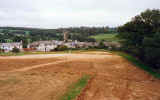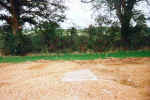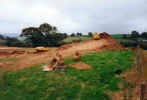


Home Galleries Playing Field main
When the old Constitutional Club was closed in about 1990 and converted into three private houses, the landowner gave the Parish an area of the field adjoining the then Playing Field on which to build a new hall. After a dedicated group of people has raised sufficient funds directly and through various grants, the hall was constructed during the winter of 1995/1996. The overall plans included a major levelling and earth-moving scheme to provide as large a reasonably flat area as possible as a playing surface.
The new Hall itself had to be set down as low as possible behind the road hedge to satisfy planning requirements. This required a major excavation deep down into the underlying shellit. First of all, the topsoil was removed from practically the entire area and placed in an enormous pile at the top of the field. The levelling and general landscaping of the overall area was then carried out, incorporating the excavated material from where the Hall was to be built. The topsoil was then replaced, ready for seeding. Unfortunately, adjustments to soil levels were required, which disturbed the underlying stony layer, bringing large quantities of stones to the surface. Check out the photographic record below of the levelling process.
The surface was not ready for seeding until early May of 1996, rather late in the year for sowing grass seed. So only half the purchased seed was sown in case of a failure. In the event, the opposite happened. Heavy rain nearly washed the seed away, but it didn't and the seed grew. Volunteers spent many hours stone-picking so that the surface would eventually safe for the children to play on. The original intention was to rake and sow the remaining half of the seed in the autumn of 1996, but this never happened. Probably just as well when you see how thick and lush the grass is most of the time nowadays.
Extensive tree planting (to meet planning requirements) was carried out in the autumn of 1996, largely financed by generous donations to a tree sponsorship scheme, and supported by South Hams District Council who supplied the trees. These were actually delivered at the end of January 1996 but the planting areas were not ready at that time. So the trees were heeled in for the summer in a nearby garden. You wouldn't believe how much root growth a young ash tree can put on in one growing season, rendering some of them quite difficult to lift in the autumn
In parallel with the construction of the new
Parish Hall in 1995/1996, a major levelling and earth-moving scheme was
implemented to provide a good-sized flat playing area.
Firstly,
the topsoil was stripped from most of the site, revealing midway along the
southern edge the capped well which once provided water to the old
Constitutional Club (but no other archaeological treasures), and "Mount
Harberton" was created.
This offered new, albeit short-term, unique views of the village, such as Tristford Farm and Wesley Place, and was a dominant feature in the landscape:
In the early days of October the levels were built up behind the old "mound", using the excavated material from where the Hall was to be built and the shellit being quarried out at the north-west corner of the field, until it was a mound no more.
With all the topsoil removed, the RAF came to inspect. By 18 October topsoil was being battered up to cover the exposed shellit on the west and north banks, and the south bank (later to be planted with trees) pictured here on 2 November also had soil applied.
By 6 November, half the "Mount Harberton" topsoil had been redistributed.
Unfortunately, adjustments to soil levels were required later in the winter, which disturbed the underlying stony layer, bringing large quantities of stones to the surface. The surface was not ready for seeding until early May of 1996, rather late in the year for sowing grass seed. So only half the purchased seed was sown in case of a failure. In the event, the opposite happened. Heavy rain nearly washed the seed away, but it didn't and the seed grew. Volunteers spent many hours stone-picking so that the surface would eventually be safe for the children to play on. The original intention was to rake and sow the remaining half of the seed in the autumn of 1996, but this never happened. Probably just as well when you see how thick and lush the grass is most of the time nowadays.